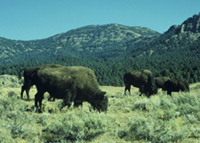Syracuse Views Summer 2024
We want to know how you experience Syracuse University. Take a photo and share it with us. We select photos from a variety of sources. Submit photos of your University experience by filling out a submission form or sending it directly…

 “During the late 1980s, similar concerns were raised about the size of the park’s elk herd and whether the herd was negatively impacting grasslands,” says Frank, a professor in SU’s
“During the late 1980s, similar concerns were raised about the size of the park’s elk herd and whether the herd was negatively impacting grasslands,” says Frank, a professor in SU’s